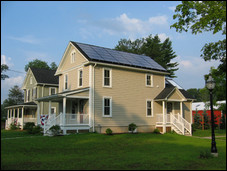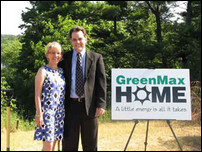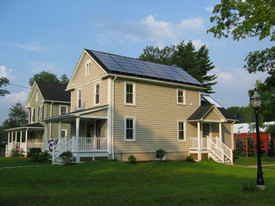Zero-energy homes, or ZEHs, were just a great idea several years ago. But with research and incentives, they are gradually becoming a reality in several parts of the country.
 Asdal Companies produced the country’s first net-zero remodeling project with its transformation of this Civil War-era cottage in New Jersey. |
Netting Zero Energy
According to the U.S. Department of Energy (DOE), ZEHs have “the potential to reverse national upward trends in home energy consumption for the entire U.S. housing stock.” A net-zero energy home is designed to produce as much energy as it consumes in a year. That is accomplished by creating a home that is well-designed, well-sealed and insulated, and uses on-site renewable energy such as photovoltaic panels and solar water heating. It is connected to the grid and may use more energy than it produces on some days but “nets” zero over a year.
“There are zero-energy homes, custom and production built, that work and are being lived in,” says Paul Norton, senior engineer with the National Renewable Energy Laboratory in Golden, Colo. “Can we build every house that way? Not yet, but codes are moving that way. You could say we have gone beyond the advanced prototype phase into the early market introduction.”
 Asdal Companies produced the country’s first net-zero remodeling project that started with this rough-looking Civil War-era cottage. |
Levels of Efficiency
The National Association of Home Builders (NAHB) Research Center in Upper Marlboro, Md.; the National Renewable Energy Laboratory and the U.S. Department of Energy’s public/private collaboration known as Building America are developing energy solutions for new and existing homes.
There are already Energy Star homes that are at least 15 percent more energy-efficient than homes built to the 2004 International Residential Code. In February 2008, the DOE announced a Builders Challenge to have homes built to new efficiency measures based on Building America’s high performance home strategies. Those homes would have to measure at least 70 on an EnergySmart Home Scale, or E-Scale.
The E-Scale rating for a home is determined after the home is performance-checked using the Home Energy Rating System (HERS) Index, developed by the Residential Energy Services Network. The E-Scale provides a context to determine relative efficiency of homes in a region. A typical home built to code would be 100 on the scale. An Energy Star home would be 85, meaning that home would use 15 percent less, or 85 percent, of the energy of a typical home. A Builders Challenge home, at 70 or less, would be that much more efficient. The zero-energy home, at zero, would be the best.
The Builders Challenge threshold of 70 on the E-Scale is expected to stay at that level until 2012. As greater efficiency levels become available, the Challenge threshold would edge closer to zero.
The DOE expects that by 2030, builders will have the methods and technologies to cost-effectively construct net-zero energy homes anywhere in the United States. The challenge is to get to “cost neutral,” where the added first costs of system enhancements amortized over 30 years would equal monthly energy cost savings from the enhancements.
Projects and Outcomes
Here’s a quick look at some zero-energy home projects around the country and the lessons learned from each home.
Two-story colonial in Maryland
Bob Ward Companies, one of the largest homebuilders in metro Baltimore, Md.,
 Bob Ward Companies offers consumers the option of an ultra-efficient home with its MEG, Maximum Efficiency Greenland, series. |
teamed up with the National Association of Home Builders Research Center to develop a zero-energy home as a training and educational endeavor. The 2,566-square-foot two-story colonial with a full basement and attached garage was constructed in 2005.
Purchasing Manager Joe Gregory says that trying to get to a net-zero home takes time, effort and money. While the demonstration home only got to 80 percent of the net-zero goal, it did go far beyond efficiencies typically offered. The company now offers homes to an ultra-efficient level that, minus the solar electric, save 13,934 kwh a year beyond typical construction in that region.
“Adding solar electric and solar hot water has a lot to do with where the home is being built,” says Gregory. “Some states have residential incentives available. For somebody to try to do it around here, it’s out of reach for the average home buyer.”
Many consumers are not yet making the connection between energy enhancements now and future savings, even with the area’s hefty jump in electric rates last summer, he says. There will be long-term effects to their bank account as well as to greenhouse gases. “Even with PV panels and solar hot water, people still wanted to pay the same as a market house,” he says.
 Bob Ward Companies offers consumers the option of an ultra-efficient home with its MEG, or Maximum Efficiency Greenland, series that can include solar electric and solar water heating systems. |
Denver affordable housing project
The NREL teamed up with Habitat for Humanity of Metro Denver to develop a ZEH for the affordable housing sector in cold climate. The approximately 1,200-square-foot, three-bedroom home with a crawlspace used envelope efficiency, efficient equipment, appliances and lighting, and passive and active solar features to reach the zero energy goal. It took advantage of off-the-shelf technologies, volunteer labor and computer simulation for the design. The $125,000 for the Habitat ZEH included the cost of solar thermal and PV but not land and landscaping. A mother and her two young boys moved into the home in October 2005.
NREL’s Norton says that his two full years of monitoring the home has found it to be a net producer of energy, producing 24 percent more energy than it consumed in one year, with just a bit less energy produced the second year.
“The science is there. But getting a marketable ZEH is a challenge. Can you get the costs low enough to make it a marketable product? Access to funding on city, county, state and federal levels can make the difference,” says Norton.
The household’s utility bill has averaged $17.14 of which $16.75 was the fixed charge. “Zero energy does not necessarily mean zero energy bills,” says Norton. “There are set fees from utilities and arrangements for compensation by each utility is different. If this home were located in Oak Ridge, Tenn., for example, the household would be getting a check from the utility.”
New Jersey remodel
Asdal Companies of Chester, N.J., was the first builder in the nation to create a zero-energy remodel. An abandoned Civil War-era cottage on a rural property was the subject of its cooperative effort with the NAHB Research Center and the NREL. Building America funded the design, development and testing of energy-saving systems. The strategy was to minimize energy consumption while obtaining on-site power from natural sources.
The cottage is home for two adults and their teenage son. The modeled loads and the actual loads vary but the dollar net is still positive with the net metering and a renewable energy “credit” from the power company. “From the sale of these credits, we actually make money operating the building to the tune of about $2,800 annually on energy,” says company CEO Bill Asdal.
Asdal says the greatest difference between typical remodeling and aiming for zero energy was that “the level of care and detailing are geometrically higher.” He had to train all the trades in the strategy, and quality control checks were made almost daily. “This level of oversight and care adds to overhead and raises the cost of the product. Testing in and out are fundamental to achieving a higher building performance.”
What surprised him in the effort was how air leakage was far more important than insulation values. “We have been focused on insulation for decades while missing the ball on air sealing needs,,” he says. What was not a surprise was customer behavior. “They need training and a mindset to minimize consumption.”
Asdal said his first energy-efficiency demonstration model was in Las Vegas in 2000. “For about $2,000 of incremental investment, we achieved a 44 percent reduction in energy costs. It was a 16.7 percent return on investment. There is nowhere for a consumer to get this return in any financial market. It does make sense to invest in energy savings and begin to think life-cycle costing rather than the consumer’s fixation with first cost.”
Wisconsin residence
Construction is expected to be completed by the end of 2008 on what is believed to be the first practical production in the Upper Great Lakes region of a net-zero residential home that can be reasonably and affordably replicated in a cold-climate region.
The 1550-square-foot prairie-style home with roughed-in basement is being built as a GreenMax Home under a program of Wisconsin Public Power Inc. Homeowners Tom and Verona Chambers collaborated with a home performance specialist and WPPI using computer modeling to help determine requirements. The home will use a PV system, a ground source heat pump for space conditioning and improved wall construction and insulation.
The Chambers are committed to efficient use of energy and reduced their plan for a north side wall of glass by 40 percent. They will work with WPPI to monitor their energy use.
Kurt Pulvermacher, energy service representative for WPPI, says paying special attention to overall building practices, including wall details, was key in the design of the home. “The Chambers concentrated on reducing the overall energy load in the home by focusing on an advanced wall-framing system that accounts
 Homeowners Tom and Verona Chambers have designed and are constructing the first net-zero energy home in the Upper Great Lakes region. |
for both better insulation and air sealing. In addition, basements in typical Wisconsin homes are big energy losers so they concentrated on reducing energy losses with an improved insulation package there as well.” The design phase also included ways the Chambers could reduce their non-space conditioning loads, including the installation and use of all Energy Star appliances. Pulvermacher expects that the home’s blower door test at CFM50 will show less than 500, compared to a typical home’s 1,800.
The photovoltaic panels, capable of producing 5.7kw in an hour of optimum sunlight, are on a base that can track the Sun across the sky. A tracking system typically provides 30 percent more production than would a stationary set-up. The system, as well as the energy-efficiency upgrades, will cost about $90,000. Federal tax credits, the state Focus on Energy public benefits program’s incentives and a $50,000 WPPI grant will bring the cost down to $23,000 for the homeowners. “It’s coming down to economics,” says Pulvermacher.
Once the home is completed, its energy production and use can be monitored through updates on the WPPI GreenMax Home Web site.
Costs and Attitudes
As the concept of zero-energy homes makes its way into the marketplace, two factors play big roles: cost and consumer attitude.
Costs. It can be cost-effective to reduce the energy usage in a home by up to 50 percent through air sealing, insulation, proper appliances and such. But adding the renewable energy sources that can get a home to net-zero energy usage can be expensive upfront.
Having incentives at the local, county, state and federal levels does have an impact. Consumers in many areas enjoy credits, grants and rebates that can help them pay up to 50 percent of the costs of installation. However, incentives are not uniform across the country. Some areas have few or no incentives, making the renewable idea seem cost-prohibitive.
Simple payback calculations can dominate thinking, says NREL’s Norton. “There’s a whole series of benefits not included in the cost: efficiency features, improved durability and comfort of the home, and societal benefits,” he says. “It also should be looked at as a good hedging strategy, hedging set rates against utility rates that could be a lot higher in 20 years.”
Attitude. Consumer attitude is important in the move to ZEH. According to Lew W. Pratsch, project manager with the DOE’s Building America program, research discovered that optional ZEH was the hardest to sell. However, pre-plotted subdivisions with from 10 to 30 percent ZEH homes sold as fast as other homes, and full ZEH subdivisions in the West sold faster than nearby conventional subdivisions. DOE surveys also found that homebuyers do not seek ZEH but like it—and brag about it—once they have it.
Having an energy conservation state of mind also plays a role. While designers can plan for most requirements for a zero-energy home, the one thing they can’t account for is how the occupants will behave. In one home designed to be net-zero energy, the occupants ended up adding many non-Energy Star recessed lights and did not use the programmable thermostat or other energy-saving devices—effectively negating many of the enhancements.
Bill Asdal says consumer behavior is tops in the bucket of solutions. “There is plenty to do without ever picking up a hammer, from seasonal window usage to appliance operation to filter cleaning and more.”
NREL’s Norton says the tricky part in designing a ZEH is to account for the very variable plug load. Called MELs, miscellaneous electric loads, they are the occupants’ big screen TV, hair dryer and such. “In a ZEH, the home and the occupants make or miss the target together.”
Read other Green Homes Special Series articles here.
Credit: Renovate Your World




























